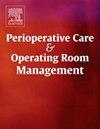在全国静脉输液短缺的情况下急性肾损伤:前后对比研究
IF 1
Q2 Nursing
Perioperative Care and Operating Room Management
Pub Date : 2025-06-10
DOI:10.1016/j.pcorm.2025.100505
引用次数: 0
摘要
2024年的飓风“海伦”导致美国各地静脉注射(IV)液突然短缺,激活了医院限制液体利用的策略。这种短缺的临床影响尚不清楚。本研究旨在描述在医院反应期间液体保存策略对急性肾损伤(AKI)率的影响。方法采用单中心回顾性研究方法,对2024年9月至10月静脉输液不足5周的大手术患者进行研究。将患者按每周进行分组,以静脉输液不足前一周为对照组(T1)。主要结局是术后7天内的急性肾损伤(AKI),由KDIGO标准定义。多变量逻辑回归评估了每个阶段与AKI之间的关系,调整了混杂因素。结果5周共503例患者(T1: 108例,T2: 127例,T3: 92例,T4: 99例,T5:77例)。各组的基线特征相似。AKI发生在T1的2.8%,T2的3.9% (OR 1.88, 95% CI 0.40-8.89, P = 0.424), T3的6.5% (OR 3.53, 95% CI 0.77-16.3, P = 0.105), T4的5.1% (OR 1.45, 95% CI 0.31-6.84, P = 0.638), T5的3.9% (OR 1.36, 95% CI 0.25-7.35, P = 0.720)。各组AKI发生率均高于T1组,可能存在临床差异,但无统计学意义。结论急诊减少策略与维护患者安全相关。虽然研究结果表明液体保护措施对AKI发病率有影响,但没有统计学意义。需要广泛的研究来证实这些发现。本文章由计算机程序翻译,如有差异,请以英文原文为准。

Acute kidney injury amid a national shortage of intravenous fluids: A before-and-after study
Introduction
Hurricane Helene in 2024 resulted in a sudden shortage of intravenous (IV) fluids across the US, activating hospital strategies to limit fluid utilization. The clinical impact of this shortage remains unclear. This study aims to describe the effect of fluid conservation strategies on acute kidney injury (AKI) rates during a hospital response.
Methods
This is a single-center retrospective study of patients undergoing major surgery during five weeks of IV fluid shortage from September to October 2024. Patients were categorized into groups per week, using the week before the IV fluid shortage as the control group (T1). The primary outcome was acute kidney injury (AKI) within seven days post-surgery, defined by KDIGO criteria. A multivariable logistic regression assessed the association between each phase and AKI, adjusting for confounders.
Results
The study had 503 patients in 5 weeks (T1: 108, T2: 127, T3: 92, T4: 99, T5:77). Baseline characteristics were similar across groups. AKI occurred in 2.8 % of T1, 3.9 % of T2 (OR 1.88, 95 % CI 0.40–8.89, P = 0.424), 6.5 % of T3 (OR 3.53, 95 % CI 0.77–16.3, P = 0.105), 5.1 % of T4 (OR 1.45, 95 % CI 0.31–6.84, P = 0.638), and 3.9 % of T5 (OR 1.36, 95 % CI 0.25–7.35, P = 0.720). All groups had a higher AKI rate than T1, suggesting a possible clinical difference without reaching statistical significance.
Conclusions
Emergency reduction strategies were associated with maintaining patient safety. While findings suggest an impact of fluid conservation measures on AKI incidence, it was not statistically significant. Extensive studies are needed to confirm these findings.
求助全文
通过发布文献求助,成功后即可免费获取论文全文。
去求助
来源期刊

Perioperative Care and Operating Room Management
Nursing-Medical and Surgical Nursing
CiteScore
1.30
自引率
0.00%
发文量
52
审稿时长
56 days
期刊介绍:
The objective of this new online journal is to serve as a multidisciplinary, peer-reviewed source of information related to the administrative, economic, operational, safety, and quality aspects of the ambulatory and in-patient operating room and interventional procedural processes. The journal will provide high-quality information and research findings on operational and system-based approaches to ensure safe, coordinated, and high-value periprocedural care. With the current focus on value in health care it is essential that there is a venue for researchers to publish articles on quality improvement process initiatives, process flow modeling, information management, efficient design, cost improvement, use of novel technologies, and management.
 求助内容:
求助内容: 应助结果提醒方式:
应助结果提醒方式:


